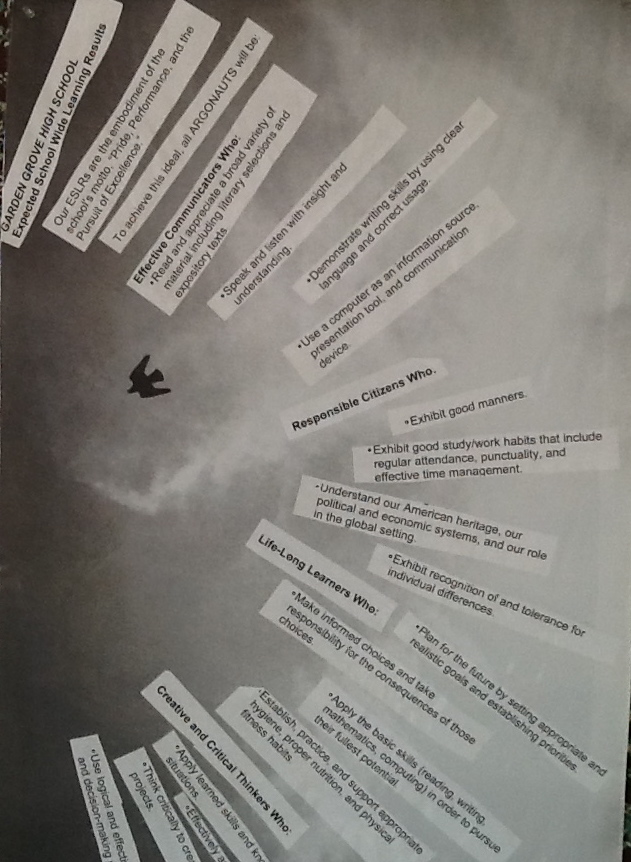 Expected Learning Outcomes
Expected Learning Outcomes
• Discuss key issues in the development of Mexican American literature
• Integrate a discussion of contemporary Mexican American issues with an array of past and contemporary Mexican literature, verbally and in writing
• Identify the varieties of Mexican American identity demonstrated and expressed in diverse forms of cultural production.
• Research the historical context Mexican American literature
• Identify major authors in major periods of Mexican American literary production
Texts, Materials, and Technology
Composition Book, Glue Stick, Writing Utensils, AERIES & Google Drive Account
Homework & Assignments
NOTEBOOKS, which include both class and homework, will be collected every three weeks. (See interactive Notebook Rubric and Guidelines for details.) All assignments are to be turned in the day they are due.
Make-ups are permitted for tests, quizzes, homework, etc. following an excused absence. Students are solely responsible for informing themselves about work missed during absences. Worksheets and assignments will be listed on the weekly class calendar. Worksheets may be picked up at the assignment basket.
Late work will be reduced 10% for each day it is late. Excessive late assignments are cause for a conference with your parents/guardians. I am regularly available to students that are having difficulties with the materials.
Grades will be based on tests, quizzes, homework packets, projects, writing assignments, and participation. The value of each of these components at the outcome of the semester is as follows:
30% Writing Assignments & End of Unit Projects
30% Tests
30% Notebook
10% Quizzes
Grading Scale
I will be grading you based on the knowledge and understanding that you show. Every assignment and assessment will be given a level of mastery score between one and five in a given category (this is NOT a point value). These scores will be averaged to determine a score of 1–5 in each grading category. At the end of the semester, a letter grade will be assigned based on the average of the 1–5 scores of all the grading categories (using the percentages listed below to weight the categories). You will have opportunities to redo assignments or retest assessments to demonstrate a possible higher level of mastery. If a higher level of mastery is demonstrated, it will replace the lower score for that assignment or assessment.
5 – Demonstrates ADVANCED Understanding of Standards and exceeds assignment requirements.
- Standards Mastery: ALL of the assignment skills and requirements are evident and EXCEEDED.
- I know it even better than my teacher taught it, or I can use what I learned in a new way.
4 – Demonstrates PROFICIENT Understanding of Standards and meets all assignment requirements.
- Standards Mastery: ALL of the assignment requirements are evident and met.
- I know it just the way my teacher taught it.
3 Points – Demonstrates a BASIC understanding of Content Standards and meets some assignment requirements.
- Standards Mastery: Basic assignment skills and requirements are evident but there are errors regarding more complex ideas and processes.
- I know some of the simpler stuff, but can’t do the harder parts.
2 Points – Demonstrates a BELOW BASIC understanding of Content Standards and meets few assignment requirements.
- Standards Mastery: Shows partial knowledge of some basic skills and requirements but there are major errors that demonstrate a need for further practice.
- With some help, I can do it.
1 Point – Demonstrates a FAR BELOW BASIC understanding of Content Standards and meets few assignment requirements.
- Standards Mastery: Most assignment requirements are not evident and no skills or knowledge of the standard are demonstrated.
- Even with help, I can’t do it because I do not understand.
0 Points – (Does not meet Standards)
- Unscoreable or no product
- I didn’t turn anything in or showed no effort.
 Daily Procedures and Behavioral Objectives ALL members of the classroom community have a right to learn in a positive learning environment where they are respected and supported. Therefore, every member of the community will:
Daily Procedures and Behavioral Objectives ALL members of the classroom community have a right to learn in a positive learning environment where they are respected and supported. Therefore, every member of the community will:
- Be in their assigned seat prepared to work when the tardy bell rings.
- Bring all required supplies and learning materials to class.
- Keep cell-phones off and refrain from texting in class.
- Practice respect for diverse backgrounds, perspectives, and opinions.
- Refrain from speaking out of turn.
- Stay seated and wait for dismissal from Ms. Alba. In other words, the bell does not dismiss class. ONLY Ms. Alba can dismiss class.
- Keep the classroom clean and organized.
- Ask for support and provide it when required.
- Challenge themselves to do their best!
- REPRESENT themselves accurately through actions and words.
Interactive Notebook Guidelines & Rubric
Your Interactive Student Notebook will be your property and the key to success in my class. It will contain notes, handouts, and valuable information concerning class material. It will also contain your thoughts, creativity, and personality – so take care of it! Your Interactive Student Notebook must come to class every day! This is essential—along with quizzes it is 40% of your grade!
Your Interactive Student Notebook must contain the following aspects:
1. A COVER with your basic information – your name, the course name, your class period, and my name.
2. A TABLE OF CONTENTS identifying the material contained in the notebook in chronological order and the page number in your notebook.
3. All materials that are contained in your notebook must be complete and have a title,including the date. This is primarily aimed at class materials, such as starters, notes and diagrams, as well as homework assignments and readings.
